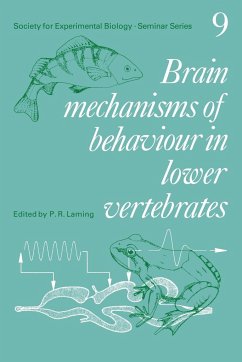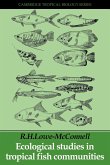Brain Mechanisms of Behaviour in Lower Vertebrates
Herausgeber: Laming, Peter R.; Laming, P. R.
Brain Mechanisms of Behaviour in Lower Vertebrates
Herausgeber: Laming, Peter R.; Laming, P. R.
- Broschiertes Buch
- Merkliste
- Auf die Merkliste
- Bewerten Bewerten
- Teilen
- Produkt teilen
- Produkterinnerung
- Produkterinnerung
First published in 1981, this book is about how the brain controls the behaviour of lower vertebrates.
Andere Kunden interessierten sich auch für
![Ecological Studies Trop Fish C Ecological Studies Trop Fish C]() Ro McConnellEcological Studies Trop Fish C61,99 €
Ro McConnellEcological Studies Trop Fish C61,99 €![Physiology and Form of Fish Circulation Physiology and Form of Fish Circulation]() Geoffrey H. SatchellPhysiology and Form of Fish Circulation48,99 €
Geoffrey H. SatchellPhysiology and Form of Fish Circulation48,99 €![Narwhal Daily Planner 2021: Beautiful Monthly 2021 Agenda Year Scheduler 12 Months: January - December 2021 Large Funny Animal Planner with Marine Narwhal Daily Planner 2021: Beautiful Monthly 2021 Agenda Year Scheduler 12 Months: January - December 2021 Large Funny Animal Planner with Marine]() Feel Good PressNarwhal Daily Planner 2021: Beautiful Monthly 2021 Agenda Year Scheduler 12 Months: January - December 2021 Large Funny Animal Planner with Marine12,99 €
Feel Good PressNarwhal Daily Planner 2021: Beautiful Monthly 2021 Agenda Year Scheduler 12 Months: January - December 2021 Large Funny Animal Planner with Marine12,99 €![Investigation Of The Salmon Fisheries Of The Yukon River Investigation Of The Salmon Fisheries Of The Yukon River]() Investigation Of The Salmon Fisheries Of The Yukon River16,99 €
Investigation Of The Salmon Fisheries Of The Yukon River16,99 €![Seal and Salmon Fisheries and General Resources of Alaska Seal and Salmon Fisheries and General Resources of Alaska]() States Dept of the Treasury SpeciaSeal and Salmon Fisheries and General Resources of Alaska29,99 €
States Dept of the Treasury SpeciaSeal and Salmon Fisheries and General Resources of Alaska29,99 €![Sharks R Amazing! Sharks R Amazing!]() Adam GalvinSharks R Amazing!14,99 €
Adam GalvinSharks R Amazing!14,99 €![Fishing From the Earliest Time Fishing From the Earliest Time]() William RadcliffeFishing From the Earliest Time30,99 €
William RadcliffeFishing From the Earliest Time30,99 €-
-
-
First published in 1981, this book is about how the brain controls the behaviour of lower vertebrates.
Hinweis: Dieser Artikel kann nur an eine deutsche Lieferadresse ausgeliefert werden.
Hinweis: Dieser Artikel kann nur an eine deutsche Lieferadresse ausgeliefert werden.
Produktdetails
- Produktdetails
- Verlag: Cambridge University Press
- Seitenzahl: 332
- Erscheinungstermin: 15. März 2009
- Englisch
- Abmessung: 229mm x 152mm x 20mm
- Gewicht: 540g
- ISBN-13: 9780521281683
- ISBN-10: 0521281687
- Artikelnr.: 26221900
- Herstellerkennzeichnung
- Libri GmbH
- Europaallee 1
- 36244 Bad Hersfeld
- gpsr@libri.de
- Verlag: Cambridge University Press
- Seitenzahl: 332
- Erscheinungstermin: 15. März 2009
- Englisch
- Abmessung: 229mm x 152mm x 20mm
- Gewicht: 540g
- ISBN-13: 9780521281683
- ISBN-10: 0521281687
- Artikelnr.: 26221900
- Herstellerkennzeichnung
- Libri GmbH
- Europaallee 1
- 36244 Bad Hersfeld
- gpsr@libri.de
Contributors; Preface; Introduction P. R. Laming; Part I. Evolutionary
Perspectives in Vertebrate Neuroethology: 1. An introduction to the
functional anatomy of the brains of fish and amphibians (with comments on
the reptiles) P. R. Laming; 2. Evolution of telencephalic function in lower
vertebrates L. R. Aronson; 3. Interspecific variability in brain
organisation and its possible relation to evolutionary mechanisms S. O. E.
Ebbesson; Part II. Sensory Mechanisms and Behaviour: 4. The properties of
the visual pathway of a common freshwater fish in relation to its visual
behaviour D. M. Guthrie; 5. The telstean optic tectum: neuronal substrates
for behavioural mechanisms H. Vanegas; 6. Behavioural and
electrophysiological studies of chemosensory reactions in fish T. J. Hara;
7. Neural coding of 'worms' and 'antiworms' in the brain of toads: the
question of hardwired and softwired systems J. P. Ewert; Part III. Sleep,
Wakefulness and Arousal: 8. Sleep ontogeny in fish C. M. Shapiro, C. J.
Woolf and D. Borsook; 9. An electrophysiological study of wakefulness and
sleep-like states in fish and amphibians I. G. Karmanova, A. I. Belich and
S. G. Lazarev; 10. The physiological basis of alert behaviour in fish P. R.
Laming; Part IV. Neuronal Substrates of Appetitive Behaviour: 11.
Hypothalamic mechanisms of feeding fishes L. S. Demski; 12. The
telencephalon and reproductive behaviour in the teleost Macropodus
opercularis: effects of lesions on the incidence of spawning and egg
cannibalism R. E. Davis, J. Kassel and M. Martinez; Part V. Learning and
Memory Mechanisms: 13. Learning in teleost fish: role of the telencephalon
N. Bohac Flood and J. B. Overmier; 14. Electrical stimulation of the
telencephalon and learning in a teleost fish G. E. Savage and D. E. Wright;
15. Pituitary peptides and memory in fish D. Borsook, C. J. Woolf, D.
Vellet, I. S. Abramson and C. M. Shapiro; Index.
Perspectives in Vertebrate Neuroethology: 1. An introduction to the
functional anatomy of the brains of fish and amphibians (with comments on
the reptiles) P. R. Laming; 2. Evolution of telencephalic function in lower
vertebrates L. R. Aronson; 3. Interspecific variability in brain
organisation and its possible relation to evolutionary mechanisms S. O. E.
Ebbesson; Part II. Sensory Mechanisms and Behaviour: 4. The properties of
the visual pathway of a common freshwater fish in relation to its visual
behaviour D. M. Guthrie; 5. The telstean optic tectum: neuronal substrates
for behavioural mechanisms H. Vanegas; 6. Behavioural and
electrophysiological studies of chemosensory reactions in fish T. J. Hara;
7. Neural coding of 'worms' and 'antiworms' in the brain of toads: the
question of hardwired and softwired systems J. P. Ewert; Part III. Sleep,
Wakefulness and Arousal: 8. Sleep ontogeny in fish C. M. Shapiro, C. J.
Woolf and D. Borsook; 9. An electrophysiological study of wakefulness and
sleep-like states in fish and amphibians I. G. Karmanova, A. I. Belich and
S. G. Lazarev; 10. The physiological basis of alert behaviour in fish P. R.
Laming; Part IV. Neuronal Substrates of Appetitive Behaviour: 11.
Hypothalamic mechanisms of feeding fishes L. S. Demski; 12. The
telencephalon and reproductive behaviour in the teleost Macropodus
opercularis: effects of lesions on the incidence of spawning and egg
cannibalism R. E. Davis, J. Kassel and M. Martinez; Part V. Learning and
Memory Mechanisms: 13. Learning in teleost fish: role of the telencephalon
N. Bohac Flood and J. B. Overmier; 14. Electrical stimulation of the
telencephalon and learning in a teleost fish G. E. Savage and D. E. Wright;
15. Pituitary peptides and memory in fish D. Borsook, C. J. Woolf, D.
Vellet, I. S. Abramson and C. M. Shapiro; Index.
Contributors; Preface; Introduction P. R. Laming; Part I. Evolutionary
Perspectives in Vertebrate Neuroethology: 1. An introduction to the
functional anatomy of the brains of fish and amphibians (with comments on
the reptiles) P. R. Laming; 2. Evolution of telencephalic function in lower
vertebrates L. R. Aronson; 3. Interspecific variability in brain
organisation and its possible relation to evolutionary mechanisms S. O. E.
Ebbesson; Part II. Sensory Mechanisms and Behaviour: 4. The properties of
the visual pathway of a common freshwater fish in relation to its visual
behaviour D. M. Guthrie; 5. The telstean optic tectum: neuronal substrates
for behavioural mechanisms H. Vanegas; 6. Behavioural and
electrophysiological studies of chemosensory reactions in fish T. J. Hara;
7. Neural coding of 'worms' and 'antiworms' in the brain of toads: the
question of hardwired and softwired systems J. P. Ewert; Part III. Sleep,
Wakefulness and Arousal: 8. Sleep ontogeny in fish C. M. Shapiro, C. J.
Woolf and D. Borsook; 9. An electrophysiological study of wakefulness and
sleep-like states in fish and amphibians I. G. Karmanova, A. I. Belich and
S. G. Lazarev; 10. The physiological basis of alert behaviour in fish P. R.
Laming; Part IV. Neuronal Substrates of Appetitive Behaviour: 11.
Hypothalamic mechanisms of feeding fishes L. S. Demski; 12. The
telencephalon and reproductive behaviour in the teleost Macropodus
opercularis: effects of lesions on the incidence of spawning and egg
cannibalism R. E. Davis, J. Kassel and M. Martinez; Part V. Learning and
Memory Mechanisms: 13. Learning in teleost fish: role of the telencephalon
N. Bohac Flood and J. B. Overmier; 14. Electrical stimulation of the
telencephalon and learning in a teleost fish G. E. Savage and D. E. Wright;
15. Pituitary peptides and memory in fish D. Borsook, C. J. Woolf, D.
Vellet, I. S. Abramson and C. M. Shapiro; Index.
Perspectives in Vertebrate Neuroethology: 1. An introduction to the
functional anatomy of the brains of fish and amphibians (with comments on
the reptiles) P. R. Laming; 2. Evolution of telencephalic function in lower
vertebrates L. R. Aronson; 3. Interspecific variability in brain
organisation and its possible relation to evolutionary mechanisms S. O. E.
Ebbesson; Part II. Sensory Mechanisms and Behaviour: 4. The properties of
the visual pathway of a common freshwater fish in relation to its visual
behaviour D. M. Guthrie; 5. The telstean optic tectum: neuronal substrates
for behavioural mechanisms H. Vanegas; 6. Behavioural and
electrophysiological studies of chemosensory reactions in fish T. J. Hara;
7. Neural coding of 'worms' and 'antiworms' in the brain of toads: the
question of hardwired and softwired systems J. P. Ewert; Part III. Sleep,
Wakefulness and Arousal: 8. Sleep ontogeny in fish C. M. Shapiro, C. J.
Woolf and D. Borsook; 9. An electrophysiological study of wakefulness and
sleep-like states in fish and amphibians I. G. Karmanova, A. I. Belich and
S. G. Lazarev; 10. The physiological basis of alert behaviour in fish P. R.
Laming; Part IV. Neuronal Substrates of Appetitive Behaviour: 11.
Hypothalamic mechanisms of feeding fishes L. S. Demski; 12. The
telencephalon and reproductive behaviour in the teleost Macropodus
opercularis: effects of lesions on the incidence of spawning and egg
cannibalism R. E. Davis, J. Kassel and M. Martinez; Part V. Learning and
Memory Mechanisms: 13. Learning in teleost fish: role of the telencephalon
N. Bohac Flood and J. B. Overmier; 14. Electrical stimulation of the
telencephalon and learning in a teleost fish G. E. Savage and D. E. Wright;
15. Pituitary peptides and memory in fish D. Borsook, C. J. Woolf, D.
Vellet, I. S. Abramson and C. M. Shapiro; Index.








